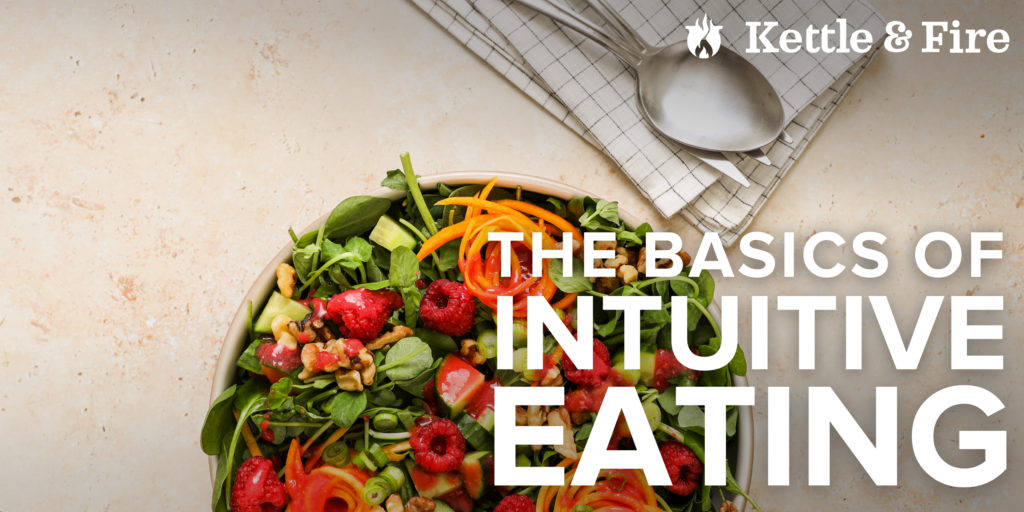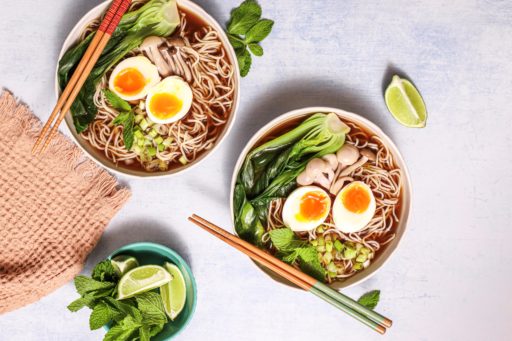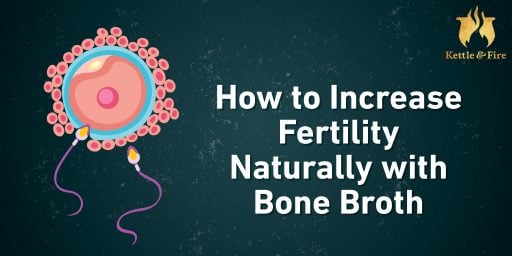A Look At Intuitive Eating

THE ANTI-DIET LIFESTYLE CHOICE
Keto. Whole30. Paleo. Low Carb. Intermittent Fasting.
We’re no strangers to different diets and the incredible benefits they provide.
We also strongly encourage healthy attachments to eating, and understand the importance of not allowing diet culture to seep into every decision, action, or thought.
Recently, a holistic nutritionist turned us on to a method of “dieting” called Intuitive Eating.
What we found is that it’s not really a diet at all, but is actually an important exercise in understanding the body and its individual needs, and prioritizing those needs accordingly in order to reap the benefits of the foods we eat.
In this post, we’ll help explain the basics behind Intuitive Eating, the perks of engaging in it, and ways you can incorporate it into your own life.
What IS Intuitive Eating?

Intuitive Eating isn’t a super complicated or restrictive diet. It’s not even really a “diet” at all, in a traditional sense.
Instead, it focuses on all types of foods, removing positive or negative attributes we assign to them. It also involves letting go of the goal to lose or gain weight for the purpose of aesthetics. Simply put, eating intuitively means that we listen to our bodies and eat what feels right for us – and eat when it feels right, too.
Here’s the Catch:
Intuitive Eating does NOT mean ordering pizza 5 nights a week because it feels “right”, or because that’s what we think we want.
The concept actually goes much deeper than that and involves the ability to tap into our body’s natural alerts that tell us when we’re either starving or satiated.
Letting go of “good” or “bad” attachments to food, learning to understand and acknowledge hunger or fullness cues, and focusing on foods that help elevate overall wellness are all key parts of Intuitive Eating.
Instead of considering it to be a diet, calling it “Conscious Consumption” might be a better way of looking at it.
What Are The Benefits?
As with any lifestyle choice, Intuitive Eating may not be right for everyone.
But one of the biggest advantages is that it is truly customizable and can be individualized as many times as needed to fit any person.
One MAJOR benefit of eating intuitively is that it removes the emotional aspects of dieting, such as:
- Eating (or not eating) to feel better about the way we look.
- Feeling guilty for straying from a restrictive plan.
- Having negative outlooks when things don’t go exactly “right”.
- Other psychological effects of diets and diet culture

The main reason some people find it difficult to stick to diets is that they aren’t often sustainable in the long run. Many times, diets are meant for quick results – and can be too difficult to follow for lengthy periods of time.
With Intuitive Eating, strict rules are thrown out of the window and focus is shifted toward physiological hunger cues rather than psychological training or manipulation.
This style of eating gets us back to the very basics of human function:
Eating when we’re hungry. Not eating when we’re not.
That’s it!
While eating intuitively doesn’t focus on the way the body looks, there are still physical benefits that come along with engaging in it.
Some people have reported achieving weight loss goals more easily, simply because they aren’t so focused on the pounds themselves, but are instead focused on using food as fuel.
Others have also found that the removal of psychological aspects of dieting have helped them maintain better mental health, which can contribute to peak emotional and physical wellness too.
How to Eat Intuitively
It’s important to note that if you are considering making Intuitive Eating part of your life, please do not do so at the expense of real health concerns.
If you are on a restrictive diet for medical reasons – or have been instructed by a doctor, nutritionist, or other expert to follow certain protocol – it’s imperative that you discuss Intuitive Eating with them before making a decision to begin.
While this method is less focused on dieting, we always recommend that any major lifestyle changes are given appropriate considerations for each individual.
That said, we put together a step-by-step guide to Intuitive Eating so you can see how easy it is to make it part of your life…when and if you’re ready to do so.

5 Steps to Achieve Intuitive Eating
1. Say Goodbye to Diets.
We said it before: we’re huge advocates for any style of eating that focuses on overall health and wellness. While we’ve shared a fair amount of resources for dieting, this form of eating rejects all of those. (No, we’re not contradicting ourselves. We’re just offering a new way for those who choose not to do Keto, fasting, or any other restrictive plan!)
In the paragraphs above, we gave Intuitive Eating a new nickname: Conscious Consumption. And that’s just what it is: being mindful of when and what we are consuming, without strict attachments to what that looks like every single day.
Frequent dieting (or “yo-yo dieting”, in which a person exchanges one diet for another quite often, or when something doesn’t work quickly) can lead to all sorts of issues, including eating disorders. Too much dieting can also deprive the body of crucial nutrients it needs to thrive.
Removing the goal of weight loss entirely may seem counterproductive, but often leads to intense improvements in relationships with food – and the self. It also helps avoid negative self-talk or feelings if the diet isn’t yielding the exact anticipated results.
2. Learn the Physiological Cues.
Eat when you’re hungry. Stop when you’re satisfied and feel fueled.
*Important Key Takeaway: feeling “fueled” is not the same as feeling “full”. Sometimes, it’s difficult to know when we are full – maybe because we are enjoying the taste of the food, or we are ignoring cues from our bodies that we are satiated, OR we’ve been taught to finish everything on our plates.
While we don’t recommend wasting food (leftovers are a thing, folks!) nor do we recommend restricting yourself if you’re, say, eating out with friends or family…we DO suggest listening to the telltale signs that you’ve had plenty.
Some of the signs that we are adequately fueled include:
- No longer feeling hunger pangs.
- Not feeling weak, famished, or faint.
- Gurgling or other cues that signal digestive processes have begun.
Hunger is generally easy to spot, but feeling fueled may take some extra work. It may be helpful to eat more slowly than you normally do, consume more water in between bites, or give yourself smaller portions to see if you are satisfied. Giving yourself time before continuing to eat can allow you to check in with your body and also helps you enjoy the process of eating more, so you’re still tapping into the happiness factor and not feeling restricted.
This level of permission allows you to indulge in what you’re eating, but still consume in a mindful way. And learning to be mindful of hunger – and satisfying that hunger – means your body doesn’t feel it has to go into overdrive starvation mode; and people tend to make better decisions when they aren’t ignoring hunger.
This method of eating also prioritizes the body’s needs for carbohydrates, protein, and other nutrients in order to transform them into energy – or to function in general.

3. Remove Emotional Attachments.
This is a BIG one. If you notice that you tend to eat when you’re stressed, depressed, anxious, or angry…don’t. (Easier said than done, we know.)
But it’s important to understand WHY you are eating just as much as it’s imperative to determine WHAT.
Giving ourselves permission to eat when we’re hungry can help remove negative emotions about it, but that’s just the first step. This step is about making peace with food and not seeing any type as “positive” or “negative”. Unless, of course, your body has certain allergies or sensitivities. But even then, that doesn’t mean you have negative attachments to those foods. It just means you consciously avoid them because you’re choosing to give your body what it really needs, instead of what it doesn’t.
When we remove these feelings about what we eat – and when – we don’t fall into the trap of seeing some foods as “forbidden” or some times of eating as “bad”. We learn to trust our very basic instincts and, in turn, our bodies are able to function better.
One way to look at it is like this: therapy is a useful tool for emotional needs. Eating is for physical and mental ones.
4. Prioritize Your Needs (and Wants!)
Here’s where the fun part begins: If you have favorite foods…EAT THEM!
Choosing foods that make you feel good is just as important as not choosing ones that don’t.
Again, this goes back to the notion that restricting certain foods just for the sake of weight loss or some other goal can create an atmosphere of resentment, depression, negativity, or something else. This can lead to triggering effects like binge eating – or can have unhealthy psychological, physical, and emotional effects.
At the end of the day, you get to choose your level of satisfaction with food. No one else. And satisfactory eating has way more benefits for us than we realize since deriving pleasure out of something cuts the core of our happiness-seeking souls.

So, give yourself a pass and allow yourself to be comfortable in your decisions.
Paying less attention to guilt-ridden diet-speak and more attention to what YOU want out of life (and food) is definitely a happier, healthier way to operate.
One dessert won’t derail your entire life’s work.
Making conscious decisions everyday WILL enhance your ultimate goals, though.
So, as long as you’re incorporating it into daily conscious consumption…you can totally have your cake and eat it, too.
5. Be Well.
This one is a no-brainer, but we felt it was a good way to round out our steps to
Intuitive Eating. Basically, this final call is for you to live a happy, healthy life by understanding – and accepting – what overall wellness means to YOU.
Some ways you can achieve this are:
- Respecting your body and the cues it gives.
- Incorporating movement into your daily routine.
- Choosing balance and nutrition when it comes to food.
- Giving yourself permission to indulge in the things you love.
- Accepting the things you cannot change, especially when it comes to your body.
- Feeling good about where you are NOW, and using it to set goals for the future.
- Not allowing your goals to dictate your every move or restrict every decision.
- Carrying yourself with dignity but also giving yourself grace.
- Rejecting the typical mentality when it comes to diets.
- Honoring imperfections as part of a process.
- Living a life you are proud to live.

Hungry after reading this post?
All of the food images are from K&F’s very own Recipe Library. Check it out to see great ideas for meals, snacks, and more!









